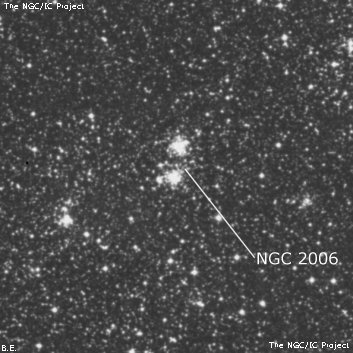
Just 0.9' N is S-L 538, a small, moderately bright glow that is sandwiched between a brighter star at the east edge and a fainter star off the west side. At 346x the shape appeared irregular and ~25" diameter. Interestingly, John Herschel's two positions for NGC 2006 on different sweeps correspond closely with each cluster, so he apparently viewed both (they are quite similar in the eyepiece) and NGC 2006 should apply to the pair. Herschel didn't note this object as double, though he commented this object was the central part of the "extremely rich assemblage of stars and clustering groups which fill the field."
John Herschel discovered NGC 2006 = h2895 on 23 Dec 1834 and recorded "a very small nucleus knot in an extremely rich assemblage of stars and clustering groups which fill the field." On his second sweep JH recorded "a small highly condensed knot in an immensely large and very rich cluster, which fills much more than the field, and is like the Milky Way." His positions differ by ~2' in declination and apply to two different close clusters! NGC 2006 is generally assigned to the southern object, with the northern cluster is S-L 538. The "immensely large and very rich cluster, which fills much more than the field, and is like the Milky Way" is known as the "Quadrant Arc".
600/800mm - 24" (4/7/08 - Magellan Observatory, Australia): forms the southern member of a close pair of small clusters (a genuine binary cluster pair!) with SL-538 less than 1' N. At 346x it appeared fairly bright, fairly small, ~30" diameter, brighter core, with no evident resolution. Forms a small triangle with two stars on the east side. Located 8' SE of NGC 2002. NGC 2006 is near the northwestern side of the huge OB association LH 77, an arcing group of clusters and stars stretching 40' E-W and including NGC 2002, 2027 and 2041 and collectively dubbed the "Quadrant Arc".
Notes by Steve Gottlieb